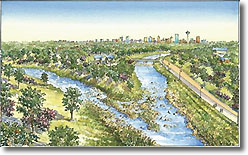 The Mission Reach project occurs along eight miles of the San Antonio River and represents the initial steps toward adding the later authorized purposes of ecosystem restoration and recreation to previously channelized streams. Features are designed to maintain the existing level of flood risk mitigation while restoring aquatic ecosystem function lost due to channelization.
The Mission Reach project occurs along eight miles of the San Antonio River and represents the initial steps toward adding the later authorized purposes of ecosystem restoration and recreation to previously channelized streams. Features are designed to maintain the existing level of flood risk mitigation while restoring aquatic ecosystem function lost due to channelization.
The Mission Reach includes restoration of pool-riffle-run sequences, river remnants, off-channel pools, sinuosity, and aquatic and riparian vegetation. Recreation is included as an ancillary, non-disruptive component of the restoration to facilitate learning, enjoyment, and interpretive opportunities for the role of the natural riverine environment in the establishment of four Spanish Colonial Missions. These missions are part of the Missions National Park, which are situated along the 8-mile Mission Reach. When complete the Mission Reach project will restore approximately 435 acres of riverine ecosystem and provides 56,000 linear feet of multi-purpose trails.
The first mile of the Mission Reach channel work has been completed, and the remaining 7 miles are under construction. A timeframe of two years is allowed after the completion of the channel work for the establishment of native herbaceous plants, grasses and wildflowers, before the final phase of construction is implemented, which is planting approximately 20,000 trees along the riparian corridor.
More information about the San Antonio Mission Reach Project...